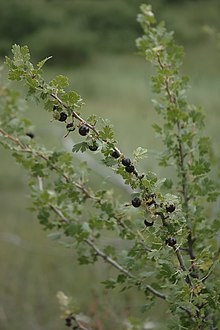Ribes leptanthum is a spiny-stemmed, small-leaved species of gooseberry in the genus Ribes commonly called trumpet gooseberry.[3] It is native to Arizona, Colorado, New Mexico, Texas, and Utah,[4] where it is usually found in high-altitude canyons.[3]
| Trumpet gooseberry | |
|---|---|

| |
| Scientific classification | |
| Kingdom: | Plantae |
| Clade: | Tracheophytes |
| Clade: | Angiosperms |
| Clade: | Eudicots |
| Order: | Saxifragales |
| Family: | Grossulariaceae |
| Genus: | Ribes |
| Species: | R. leptanthum
|
| Binomial name | |
| Ribes leptanthum A.Gray, 1849
| |
| Synonyms[2] | |
Ethnobotany
editHistorically the berries of R. leptanthum have been consumed in Native American cultures in a variety of ways: they are readily eaten fresh by Apache peoples, including the Chiricahua, Mescalero, and other peoples (specifically those in the vicinity of Isleta and Jemez in New Mexico); used as an ingredient in cakes made for overwintering by Chiricahua, and Mescalero peoples; and, in those communities where early-settling Spanish and Native American cultures have generally mingled or influenced each other, R. leptanthum berries are used in recipes for jellies and wines.[5]
References
edit- ^ NatureServe (2024). "Ribes leptanthum". Arlington, Virginia. Retrieved 2 October 2024.
- ^ "Ribes leptanthum A.Gray". Plants of the World Online. Royal Botanic Gardens, Kew. Retrieved 3 October 2024.
- ^ a b Kleinman, Russ. "Ribes leptanthum Gray". Vascular Plants of the Gila Wilderness. Western New Mexico University. Archived from the original on 3 October 2024. Retrieved 3 October 2024.
- ^ "PLANTS Profile Trumpet Gooseberry | USDA". USDA Plant Profile. Retrieved 2 June 2011.
- ^ Dan Moerman. "Search for Ribes leptanthum". Native American Ethnobotany Database. Dearborn, Michigan: University of Michigan. Retrieved June 2, 2011.
